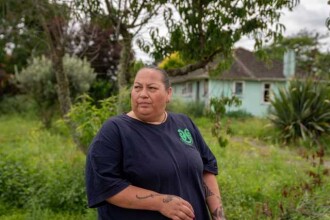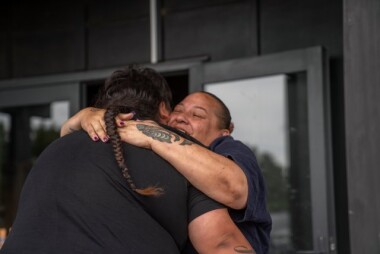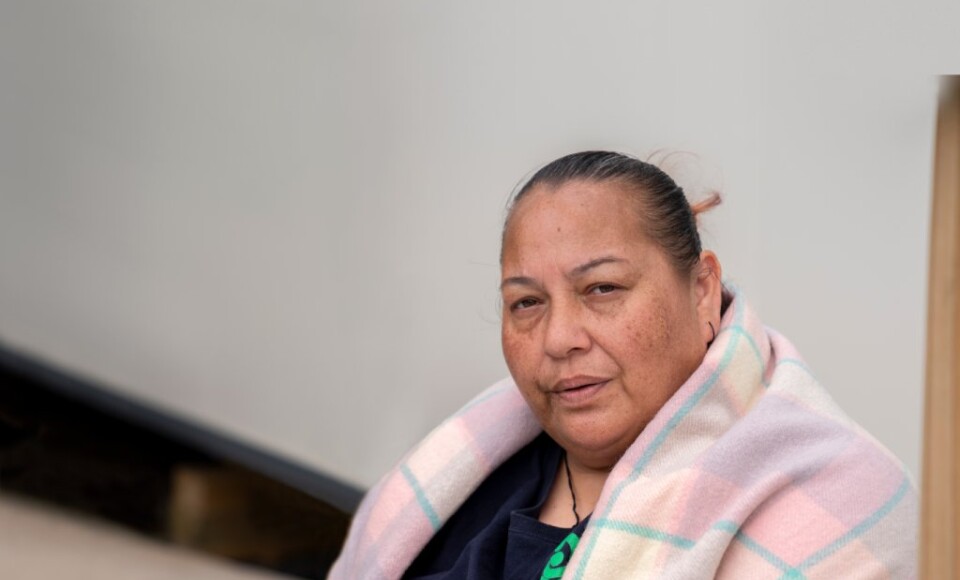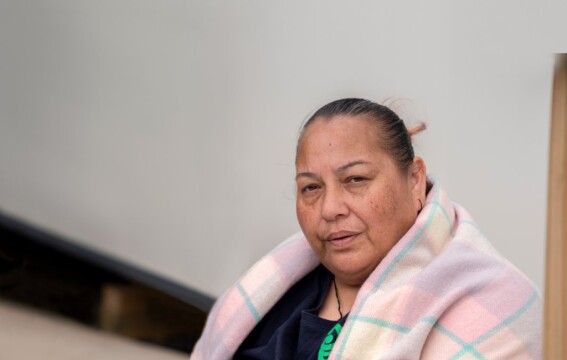Many of the homes in the small Hawke’s Bay community of Waiohiki have stayed in the same family for generations. Kiriana Laison is the fourth generation of her family to live in her home – her children are the fifth. The night flooding from Cyclone Gabrielle arrived, Kiriana was worried she had not only lost her home but her entire community – and her family.
Kiriana’s whole life was within walking distance. Her three bedroom home, with a granny flat is situated on whānau-owned land. The night of the cyclone, Kiriana was living at the property with her aunty, parents, her son and his partner, her younger son, two cats and a dog. Six paddocks away was Waiohiki Marae, which also houses Te Kohanga Reo Waiohiki Marae, where Kiriana works as a kaiawhina, cook and also van driver.
Relatives live at other houses on the whānau-owned land, all within walking distance and all intertwined in each other’s lives. It is not just community, it is family – which made the night of 14 February, 2023 all the more dramatic for her. New Zealand Red Cross has provided support to Kiriana since the first week of evacuation to today, as she prepares to return home.
Higher ground
“I went to bed at midnight on 14 February, which happened to be my birthday. I was turning 41 and my young fella had come in and gave me my birthday present,” Kiriana explained.
The family knew bad weather was coming and had prepared accordingly. The last time flooding had hit Hawke’s Bay, 35 people converged on Kiriana’s house as a safe, dry place to wait out the flooding. In preparation for the latest warning, Kiriana had procured petrol, generators and tents, to ensure they had enough if they again become a meeting place.
“So we were prepared when I went to bed that night. My son gets ready to go to work at 4.30am, and it didn’t register to him that it was water outside our door. He was still half-asleep and he went outside to start his vehicle.”
He woke her to alert her to the flooding and her immediate thoughts turned to her parents, who were on a concrete foundation and lower to the ground. On her way to their flat to wake them up, she had to save one of her cats that she found floating, sitting in its litter box.
“The water was just up to the bottom of their mattress. I tried to wake my parents up really nicely but as they do, they get a fright because somebody is in the room that’s not supposed to be there. I said ‘please, just put your feet on the ground and realise that you’ve got water coming into the house. We need to get out’.”
Kiriana’s parent immediately tried to grab valuable possessions to take with them. Her focus remained on survival.
“Me screaming at them, in return woke up a few of my neighbours. I must have been pretty loud because honestly at that moment, all I could think of was getting my parents out of that situation.”
By the time all the family were ready to go, only one vehicle would start – a hybrid. Everyone bundled into the car, with the dog able to swim into the boot, before they headed to high ground.
“I went to go jump in and I realised if we're going to be away for a couple of days, I need our meds so I went straight back into the house, grabbed everyone’s medication, came back in … and we started floating by the time I got into the car. Our car had lifted off the ground,” Kiriana explained.
“And so did every piece of whiteware that we had – our freezers, our fridges, all floating around, all still being held by that one little piece of cord keeping them grounded.

“We were pretty much floating from our driveway to the main road, which is our lane. My son was just using the steering wheel pretty much as a rudder to keep us on the right track. By the time we got to the main road, there were giant logs, trees, everything was just floating past us. It was absolutely crazy.
“We get to the bridge and I see my cousin standing there. He's standing there with his lights on his truck and he's waving, ‘Don't go cuz, don’t go’. And I'm like, ‘Why?’ He’s like ‘the bridge is gone’.
“The only option we have is to go up to our marae because it’s slightly higher than the rest of the property. So when we decided to reverse back and go into the marae, there was already a raging river between the kohanga and the marae. I said to my boy we need to get there. Just do as much as you can to get us up there.”
Keep on trucking
The car did just enough to get them there, the flooded engine stopping just as they reached the marae. With her family now on higher ground, Kiriana’s thoughts turned to those that weren’t in the car. She received a devastating phone call from her neighbour, who could not move her flatmate who was recovering from recent surgery.
“All I could do was cry because my car had died, I had no way of getting to her. I just got my parents and my kids out, and my animals. How am I going to go and help my friends, my neighbours, who are all elderly themselves and their seventies, in their eighties? The young families … all I can think of is the devastation. I'm going to lose so many of my friends because I can't help them.”
Fortunately, help came in the form of Kiriana’s uncle, who arrived in a large truck with family members on the back. With the latest batch of evacuees on higher ground, Kiriana asked her uncle to go back and rescue everyone still trapped on the lane below. He agreed, only asking for a hot cup of tea on his return.
“He was our saviour. We would have lost so many lives if it wasn’t for him coming out, everyone going door to door, picking up all our elderly, getting everybody out of their homes that were stranded on their roofs, standing on top of their cars and their vehicles. They couldn't get out of their homes.”
By 9.00am in the morning, there were close to 150 people at the marae. By 5.00pm, there were 250. Provisions were scarce – there was enough water to last half a day. Power and cellphone reception disappeared and there was no running water.
Later that day, helicopters started flying overhead, rescuing people in nearby areas. Kiriana said they had no idea of the wider scale of the flooding’s impact.
“We were waving, waiting for them to stop and pick us up, but not realising the dangers that Puketapu was going through. We had no clue that everyone else was affected – we were just worrying about us.”
Eventually a helicopter hovered overhead and took photos. A StarLink service at the marae – which had been cutting out throughout the ordeal – started working and the group were able to communicate with Civil Defence. The New Zealand Army sent Unimogs to rescue the evacuees – however a large group of elderly residents did not want to leave their whānau land. Kiriana volunteered to stay with them.
“We sent almost 120 people on the first lot of Unimogs; they all left. And it felt weird without them. We had just gone through this traumatic experience with them and it felt like we were losing half our body because, you know, we had gone through the trauma and we were so connected with each other, it felt sad. You know, majority of the ones that were left behind were crying for the ones that were leaving and vice versa.”
The Unimogs returned for the second group. The drive out was harrowing, as they saw first-hand the scale of the destruction.
“We were going from our marae to Hastings, which meant that we had to pass every single house in Waiohiki to get out. I heard my nanny in the front Unimog over all the noise that those Unimogs push out, her wailing. Which then started my parents wailing. Which then every single person you could hear was wailing because she's seen the devastation of the water and the silt of every single house that was in Waiohiki.”
Reunited
The evacuees were relocated to Waipatu Marae, just outside of Hastings. The reunions with worried family had, in Kiriana’s words “everyone ugly crying”. She describes the first few nights at Waipatu as “surreal”, as they were fed, clothed and entertained by the local marae community, who banded together to support those that had lost everything.

For Kiriana, the precious family taonga including korowai (cloaks), piupiu (skirts) that had been given to her family by a museum and their paper whakapapa (genealogy) were gone.
“All the memories and everything that they (Kiriana’s parents) had collected and
accumulated over the last 70 odd years, was still sitting in that house rotting. We had, you know, taonga that were ten generations old - gone with the river, because it just swept through everything.”
Like the Waiohiki community itself, the rebuild has been a family affair. Individual family members have set tasks and one year on, Kiriana is nearing the finish line of moving into her renovated home.
“What we thought would have only taken a couple of months, like two or three months, has taken about six or seven months for most of them. On the other side of the motorway, our Pakowhai whānau, I felt aroha for them, three quarters of them categorised 3. They had to sell their land and property because they’re not allowed to build.”
Always there
Since those initial days at Waipatu Marae, Kiriana has been supported by New Zealand Red Cross. Kiriana had previously been involved with Red Cross through first aid courses and the occasional visit to a Red Cross shop, however it was the support during those initial days that have left a lasting impression.
“We were given all this information when we first got to Waipatu – a wide array of paperwork sitting on the table one afternoon. As a whānau, we sat there before dinner and just read and just said ‘oh look, we qualify for this, we qualify for that’.”
New Zealand Red Cross collected the various grants and allowances being offered by other organisations to show what support was on offer for anyone impacted by the flooding. Through the New Zealand Disaster Fund, some of Kiriana’s relatives were able to find temporary accommodation. A Partnership Grant to another organisation allowed for cabins to be built for other members of Kiriana’s whānau to move into.
Secretary General of New Zealand Red Cross, Sarah (Norm) Stuart-Black visited Kiriana in person at her property six weeks after the cyclone. While the house was just a shell at the time, Kiriana said that her house isn now nearly ready to welcome people again.

With New Zealand Red Cross having supported Kiriana’s journey, from practical support, to a empathetic ear, she has a simple request for people thinking of donating – do it whole heartedly.
“All their intentions have to do with helping people regardless of their situation, regardless of their ethnicity, regardless of their marital situation. They just want to help. They give without expecting to receive.
“From the first get-go of us going through this until now, we’re still being supported by the Red Cross. From funding, from giving us organisations that can help us, those Q and As, furniture, pots and pans … the stuff we’ve been given is more than anything I could think of.
“You’re not just helping one person, you’re helping a community. You’re helping nationally, you’re helping internationally. Every dollar, every cent, counts. I don’t know what else to say but … thanks.”
The support Kiriana received is only possible thanks to the generosity of our supporters. Help people like Kiriana who need support the next time there is an emergency by donating this March to our Buckets of Good appeal.


